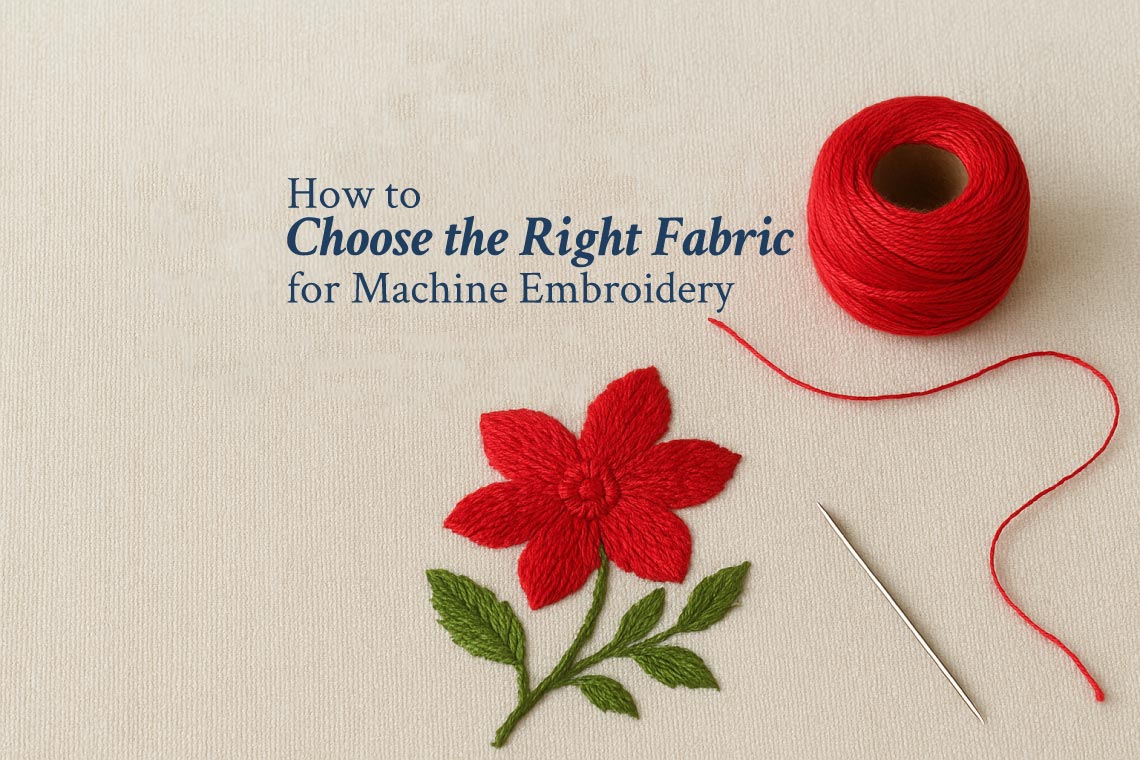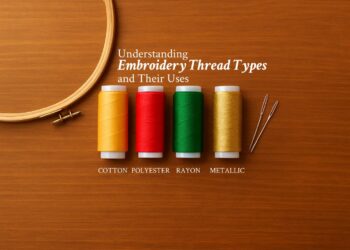Selecting the right fabric for machine embroidery can make all the difference between a beautiful, long-lasting design and one that puckers, distorts, or fades too soon. Whether you’re new to embroidery or looking to refine your technique, understanding embroidery fabric types is essential for achieving professional results. This embroidery cloth guide will help you choose the best material for your next project.
Why Fabric Choice Matters in Machine Embroidery
The fabric is the foundation of every embroidery design. Choosing the wrong type can lead to thread breaks, poor registration, or uneven stitching. The best fabric for embroidery provides stability, complements your design’s density, and enhances the overall finish.
Different fabrics react differently under the needle — some stretch, others shrink, and some require stabilizers to hold stitches properly. Knowing how to match fabric with design type and thread weight ensures your embroidery looks as good as it should.
New to embroidery? Read our guide on Embroidery Machine Basics for Beginners to understand how your fabric and needle choices affect stitch quality.
Common Embroidery Fabric Types
Here’s a breakdown of popular embroidery fabric types used in machine embroidery projects:
1. Cotton
Cotton is one of the most beginner-friendly fabrics. It’s breathable, easy to handle, and holds stitches well without excessive puckering. Ideal for home décor, apparel, and quilt embroidery.
Best for: Light to medium-density designs
Tip: Use a lightweight cutaway stabilizer for extra support.
2. Linen
Linen offers a natural, elegant texture perfect for monograms and heirloom embroidery. It’s durable yet has a loose weave that allows needle penetration easily.
Best for: Vintage-style designs or delicate floral motifs
Tip: Pre-wash linen to prevent shrinkage after embroidery.
3. Polyester and Blends
Polyester blends are wrinkle-resistant and more durable than natural fibers. They’re popular in commercial embroidery for uniforms and activewear.
Best for: High-use garments or sportswear
Tip: Use a strong, tear-away stabilizer and test a small design first — blends may stretch slightly.
4. Denim
Denim’s sturdy weave makes it perfect for bold, dense embroidery patterns. Its durability ensures your design holds up even with frequent washing.
Best for: Jackets, jeans, or tote bags
Tip: Use a heavy-duty needle and medium-weight cutaway stabilizer.
5. Felt
Felt doesn’t fray and is great for appliqué or decorative embroidery. Its thickness provides a solid surface for stitches to sit beautifully.
Best for: Patches, crafts, and home décor
Tip: Skip stabilizers for small designs; use them for larger motifs.
6. Silk
Silk gives embroidery a luxurious look but requires careful handling. Because it’s delicate and slippery, stabilizing is crucial.
Best for: Fine art embroidery or luxury garments
Tip: Always use a lightweight stabilizer and test your tension settings first.
Matching Fabric with Embroidery Design Density
Choosing the best fabric for embroidery depends on how dense your design is:
-
Light designs (outlines, small motifs): Use soft, lightweight fabrics like cotton lawn or linen.
-
Medium-density designs: Perfect for broadcloth, twill, or cotton blends.
-
Heavy or dense designs: Use sturdy materials like denim, canvas, or felt for best results.
Understanding this balance ensures your stitches stay neat and your fabric remains smooth.
Bonus Tip: Don’t Forget the Stabilizer
Even the best embroidery fabric won’t perform well without proper stabilization. The stabilizer prevents puckering and stretching, helping your stitches sit flat and clean.
-
Tear-away stabilizer: Great for stable fabrics like cotton or denim.
-
Cutaway stabilizer: Ideal for stretchy or delicate materials like knits or silk.
-
Water-soluble stabilizer: Perfect for freestanding lace or transparent fabrics.
Always test your stabilizer-fabric combination before starting your full design.
Final Thoughts: Your Fabric Sets the Foundation
Choosing the right fabric for machine embroidery is an art in itself. From sturdy denim to soft silk, every material brings its own charm and challenges. By understanding embroidery fabric types and their behavior, you can confidently create projects that look polished and professional.
If you’re just beginning your embroidery journey, start with easy fabrics like cotton or linen before moving on to delicate ones like silk. Remember, the fabric you choose determines not only the look but also the longevity of your embroidered piece.
Want to explore more beginner-friendly resources? Check out our Embroidery Basics & Guides section for step-by-step tutorials and expert tips.
FAQ
1. What is the best fabric for machine embroidery?
The best fabric for machine embroidery depends on your design. Cotton and linen are ideal for beginners, while denim, felt, and polyester blends are great for durable, high-density designs.
2. Can I use any fabric for machine embroidery?
You can embroider on most fabrics, but each material behaves differently. It’s important to match your embroidery fabric type with the right stabilizer to prevent puckering and distortion.
3. What fabric is easiest to embroider on?
Cotton is the easiest fabric for embroidery. It’s soft, stable, and handles needlework well without stretching — making it perfect for beginners learning machine embroidery.
4. Do I need a stabilizer for all fabrics?
Yes, stabilizers are essential for most embroidery fabrics. They provide support, prevent shifting, and keep stitches even. The type of stabilizer (tear-away, cutaway, or water-soluble) depends on your fabric and design.
5. How do I prevent puckering when embroidering on fabric?
To prevent puckering, use the correct stabilizer, tighten your hoop properly, and choose the right fabric for machine embroidery based on your design’s density. Pre-washing fabric also helps minimize shrinkage.
6. Which fabrics should I avoid for machine embroidery?
Avoid very thin, stretchy, or loosely woven fabrics like chiffon or tulle unless you have experience and use the proper stabilizers. These fabrics can distort under machine tension.




